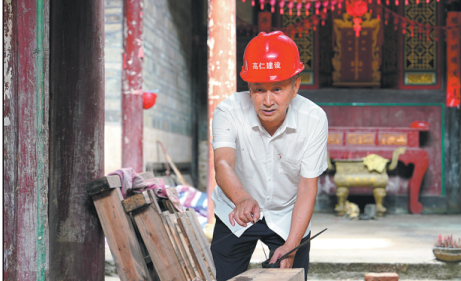On a mission to restore old Hakka houses
Master craftsman fights to protect cultural legacy in southern Jiangxi

When a rare snowfall blanketed Longnan city in Jiangxi province in January 2024, Zhong Yanpeng — a national inheritor of the technique of building Hakka enclosed houses — grew concerned. "These houses are most vulnerable in rainy or snowy weather," Zhong said.
Concerned that the cold weather could endanger these houses, he rushed back from Guangdong province to Longnan.
Zhong arrived equipped with tools and a team of maintenance workers to care for the Yan Yiwei Hakka enclosed house in Yangcun village.
With a history dating back to more than 350 years, the four-story structure is the tallest of a number of old fortified residences in the vicinity of the village.
Nestled in the mountains, Hakka enclosed houses — similar to tulou found in the neighboring Fujian province — have their origins in the late Ming Dynasty (1368-1644), when migrants from northern China settled in the south.
These migrants, known as the Hakka, which means "guest families", adapted to their new environment, developing their own dialect, customs and unique architectural style.
Jiangxi is home to over 500 historical Hakka round houses, with 376 of them located in Longnan. Due to their imposing structure, some architects liken them to Oriental Roman Castles.
With decades of experience in repairing Hakka enclosed houses, Zhong has worked on numerous structures, including Guanxi Xinwei, Yan Yiwei, Wushiwei and Xichangwei.
After conducting a routine inspection, Zhong lightly tapped the walls of the enclosed houses with a small hammer, saying, "The rammed earth is still tightly compacted."
Zhong explained that the repair materials include a mixture of lime, clay and sand, blended with unconventional ingredients such as brown sugar, egg whites and sticky rice.
After fermenting for 15 days, the mixture is combined with cobblestones and tung oil, then compacted into thick, durable walls. These walls used to provide protection against invaders and also served as living spaces.
This architectural style was added to China's tentative list of UNESCO World Heritage Sites by the National Cultural Heritage Administration in 2012.
The construction of Hakka enclosed houses in southern Jiangxi involves a variety of building techniques, making it highly complex.
"There used to be very few people who understood this," Zhong said.
In the 1980s, when Longnan faced a shortage of local craftsmen and embarked on emergency repairs of the enclosed houses, restoration work encountered significant challenges.
Growing up in a village in Longnan, Zhong developed a fascination for carpentry craftsmanship from a young age. At 16, he began learning traditional woodworking skills and later took on the maintenance of ancestral halls after completing his apprenticeship.
Since then, he has formed an inseparable bond with the restoration and protection of enclosed houses, dedicating over 50 years to their preservation.
To enhance preservation techniques, Zhong traveled to Jiangsu and Fujian provinces to study. He consulted experts and scholars, interviewed former residents and meticulously verified information, accumulating valuable experience in the protection of enclosed houses. "Each Hakka enclosed house bears a specific historical and cultural imprint," Zhong said.
"These houses must be restored to their original state, adhering strictly to ancient methods in terms of dimensions, formulas and materials. This is the essence of the Hakka enclosed house construction technique."
In 2024, Zhong was honored with the Jiangxi Good Person award.
Like other traditional skills, he is primarily concerned with how to pass on restoration techniques to future generations. "The continuity of this skill is currently my most pressing concern. As the eldest, it is my responsibility to lead by example," Zhong said.
He willingly shares his insights and experience in repairing work with anyone who asks and recommends relevant historical and cultural materials.
In May 2018, Zhong was named a national inheritor of the Hakka enclosed house construction technique in southern Jiangxi.
Under his guidance, over 50 individuals have dedicated themselves to traditional craftsmanship, engaging in the restoration of enclosed houses. The Longnan government has also made significant efforts to revitalize these old enclosed houses.
By the end of 2023, Longnan had restored nearly a hundred enclosed houses, with over 40 of them being revitalized for active use.
Li Minghua, Zhong's nephew, has become a representative inheritor of the Hakka enclosed house construction technique. "I have trained six apprentices, some of whom show great potential. However, young people are not very interested in preserving these old houses. They prefer to work on modern housing renovations in the city," Li said.
The youngest member of Li's team is over 40 years old.
"The number of people who can master the Hakka enclosed house construction technique is very few," Lin said. "We grew up in these enclosed houses, and protecting and restoring these enclosed houses is our lifelong mission."



Today's Top News
- China defends response to Japanese reconnaissance in East China Sea ADIZ
- Wang calls Rubio meeting constructive
- Tianzhou 9 cargo craft transported to launch site
- Gaokao not only way to be successful in life
- More policy options in H2 to spur growth
- Shipping industry advances green efforts






























